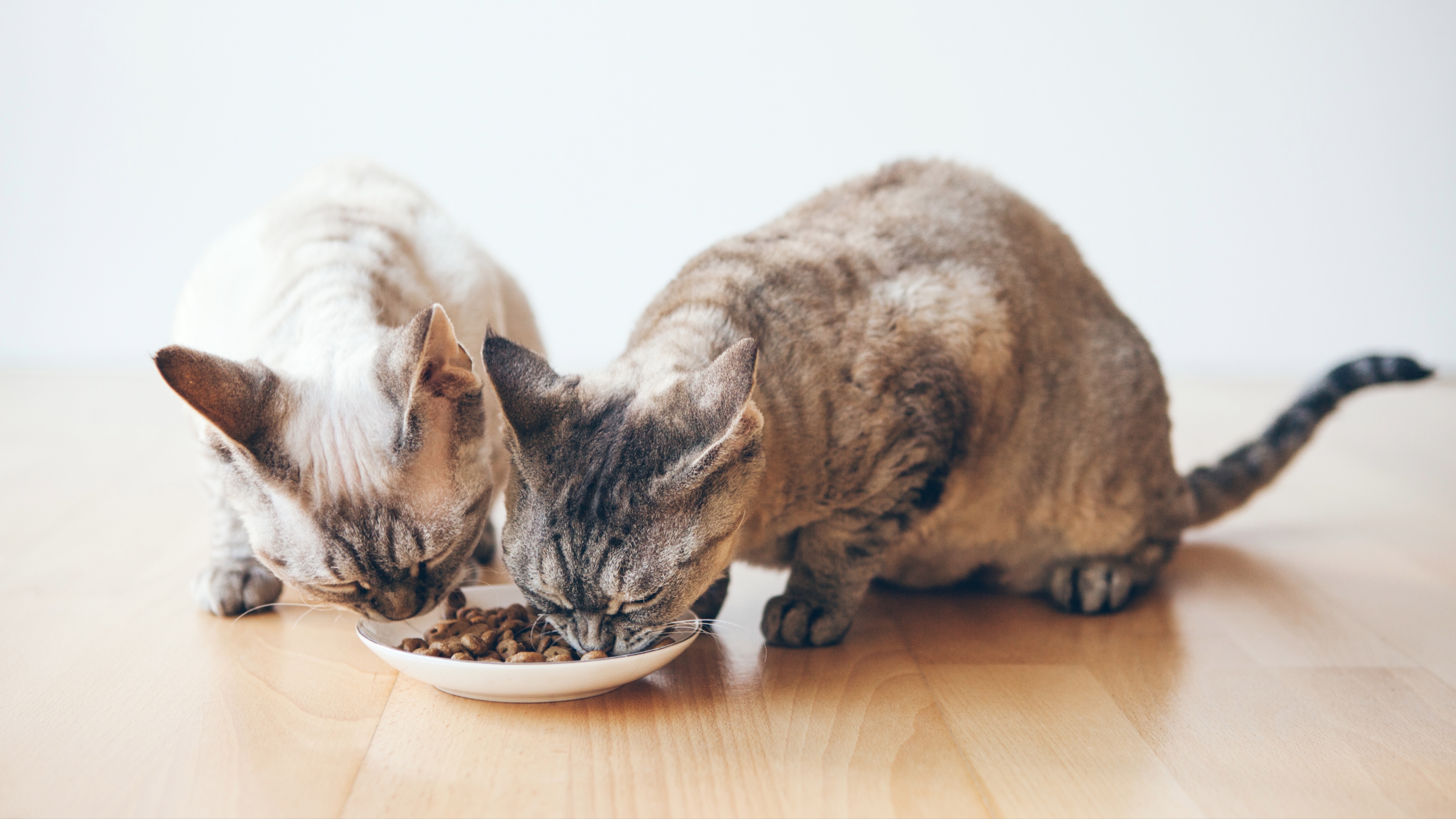Vet reveals how to manage food aggression in cats
Food aggression in cats can be challenging to deal with, but with time and patience it can be overcome. Here’s how…

Food aggression in cats is one of those issues that a lot of pet parents struggle with, so if you’re finding that your feline friend is displaying aggressive behavior at mealtimes, rest assured you’re far from alone.
Cats and kittens that struggle with food aggression are prone to growling, hissing or even attacking people and other pets who try to get close to their bowl of the best cat food or the best kitten food. Not only can this be scary for you to be on the other end of but it can also damage the bond the two of you share.
There are several things that can cause cats to display aggressive behaviors around food, such as having a history of food deprivation or an undiagnosed medical condition. While it can be a challenging issue to deal with, you can learn how to calm an aggressive cat so that mealtimes become a lot less stressful for you both.
Below, Dr. Catherine Barnette outlines everything you need to know about food aggression in cats, including what causes it, signs to be on the lookout for and some simple things you can do to help your kitty feel calmer while they eat. Let’s take a look…
Signs of food aggression in cats
The most reliable sign of food aggression is aggressive behavior (directed towards humans or other pets) that occurs around the food bowl or when food is present. If your cat demonstrates any of the following signs, you are likely dealing with feline food aggression:
- Guarding the food bowl
- Hissing or growling when the food bowl is approached by people or other pets
- Attacking people or pets when food is present
Wondering why your cat is stealing food? Or maybe you're asking why is my cat begging for food? While these may not sound like obvious signs of aggression, it's worth taking note.
Although these signs do not directly involve aggressive behavior, and therefore are not sufficient to make a diagnosis of food aggression, they seem to stem from an excessive preoccupation with food.
Get the best advice, tips and top tech for your beloved Pets
These signs may serve as a possible warning sign for food aggression:
- Meowing and pestering people when the food bowl is empty
- Frequent attempts to steal food from people
- Chewing through packaging to get to access cat food and other food items
- Loudly begging for food in the kitchen
Causes of food aggression in cats

There are many possible causes of food aggression in cats. In most cases, no specific cause can be identified. Even when we think we know what may be causing a particular cat’s food aggression, this can be difficult to confirm.
1. Food scarcity
Food aggression may be attributable to a period of food scarcity. Perhaps your cat was weaned too early as a kitten, leading to a period of malnutrition. Or maybe your cat lived outdoors as a stray for a while, never sure where they would get their next meal. Any period of food scarcity is likely to increase a cat’s desire to secure food for themselves, so they will not go hungry again.
2. Stress
Stress and anxiety in cats can also contribute to food aggression. If your cat has undergone significant life changes (recent adoption, a move to a new home, new pets in the home, etc.), this stress can trigger a wide variety of behavioral changes, including food aggression.
3. Multi-cat household
Cats in multi-cat homes also appear to be more likely to develop food aggression. They may feel the need to compete for resources, including food. Feeding multiple cats in the same household can be tricky; competition between cats may result in food aggression and other aggressive behaviors.
4. Medical issues
Finally, food aggression can have underlying medical causes. Any condition that increases your cat’s hunger, such as diabetes or hyperthyroidism, can lead to food aggression and an increased preoccupation with food.
Diagnosing food aggression in cats
Any cat with a new onset of food aggression should be evaluated by a veterinarian. Your vet will likely perform a thorough physical examination, a fecal parasite examination, and blood tests. Other tests may also be recommended, depending on the results of your cat’s physical exam. These tests are used to rule out medical conditions that may cause excessive hunger, which could be contributing to your cat’s food aggression.
If no medical cause is found for your cat’s food aggression, an underlying behavioral cause should be suspected. Your veterinarian will likely ask about your cat’s behavior at home, including how long the behavior has been present and what other behavioral changes (if any) you have observed. Through this behavioral history, your vet will determine whether your cat’s behaviors are consistent with food aggression.
How to stop food aggression in cats

The first step in managing food aggression is to avoid making the situation worse. Ensure that your cat has plenty of space at mealtime and does not feel the need to defend their food. Feed them in a quiet room, away from people and other pets. By making mealtime a more calm experience, you can decrease some of the anxiety and arousal that often accompany food aggression.
Remember that cats in the wild hunt small prey, eating many small meals throughout the day. Instead of feeding your cat one or two large meals per day, feed your cat four or five smaller meals each day. Not only does this mimic your cat’s natural feeding behavior, it can help decrease the feeling of food scarcity that often underlies food aggression.
Finally, ensure that your cat has plenty of outlets for play. Use active feeding devices, such as Doc & Phoebe’s Indoor Hunting Cat Feeder, to make mealtime more mentally and physically stimulating for your cat. Play with your cat several times per day, using teaser wands and the best cat toys. A tired cat has less nervous energy to fuel stress-related responses such as food aggression.
If your at-home efforts are unsuccessful, talk to your veterinarian. They may refer you to a veterinary behaviorist for a more detailed evaluation and comprehensive treatment plan.
Food aggression in kittens
Food aggression in kittens is very similar to food aggression in adult cats. It’s more likely to occur when you take in a kitten that has gone through a period of food scarcity, but it can be seen in any kitten. When managing food aggression in kittens, the basic steps are the same as managing food aggression in adults. Give your kitten a secure space to eat, offer multiple small meals daily, and ensure that your kitten has plenty of healthy play outlets for their energy.
Don’t ignore food aggression and hope it will go away. The earlier you start addressing behavioral problems such as food aggression, the more likely you are to achieve a successful outcome.
Food aggression in cats is a frustrating problem that does not always have an unidentifiable underlying cause. If you are struggling with feline food aggression, work with your veterinarian to rule out underlying medical causes of your cat’s behavior change. Once you have determined that your cat’s food aggression is behavioral in nature, focus on decreasing stress surrounding mealtimes and feeding small meals that encourage physical and mental activity in your cat.
For more solutions to some of the most common issues encountered by pet parents, we recommend taking a look at our guide to the top kitten behavior problems and how to fix them.

Dr. Barnette is a graduate of the University of Florida, where she received both her B.S. in Zoology and her Doctor of Veterinary Medicine (DVM). She has 15 years of clinical experience as a small animal veterinarian, treating dogs, cats, and occasional exotic patients. She now works as a freelance veterinary writer, creating educational content for veterinarians, veterinary team members, and dedicated pet owners.
Dr. Barnette is a graduate of the University of Florida, where she received both her B.S. in Zoology and her Doctor of Veterinary Medicine (DVM). She has 15 years of clinical experience as a small animal veterinarian, treating dogs, cats, and occasional exotic patients. She now works as a freelance veterinary writer, creating educational content for veterinarians, veterinary team members, and dedicated pet owners. Dr. Barnette lives in southwest Florida with her husband and daughter (plus two cats, a dog, and a rescued dove!) and enjoys kayaking, biking, and hiking. Learn more about Dr. Barnette at www.linkedin.com/in/catherinebarnette.
- Kathryn WilliamsFreelance writer

